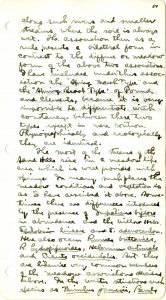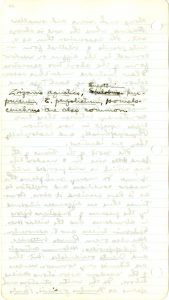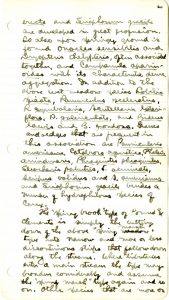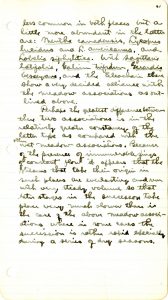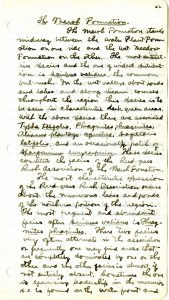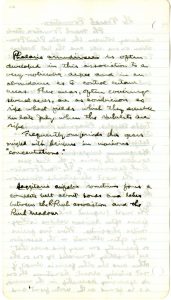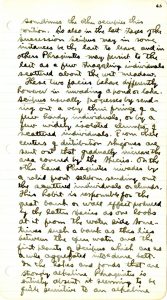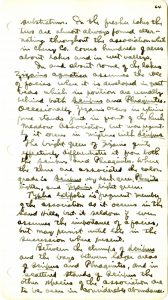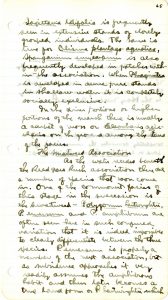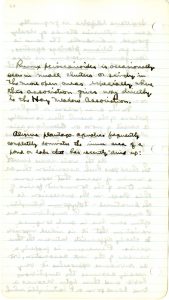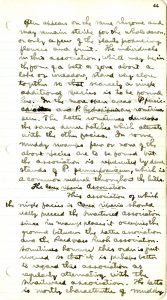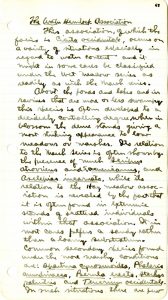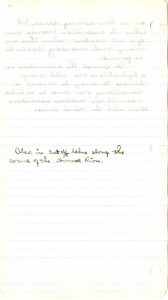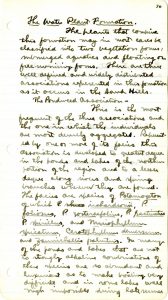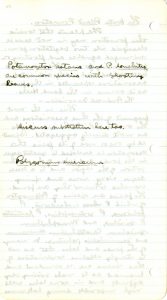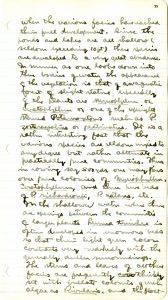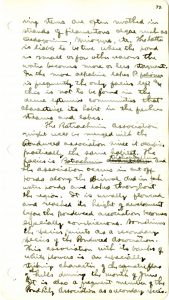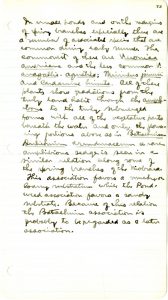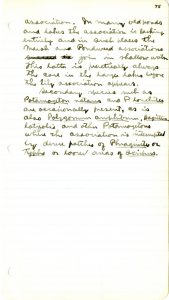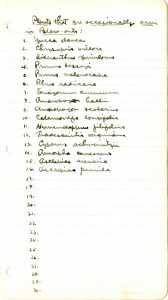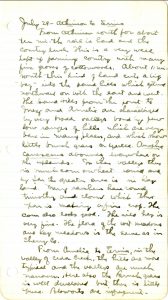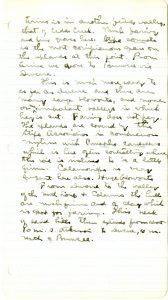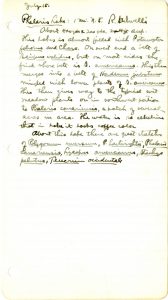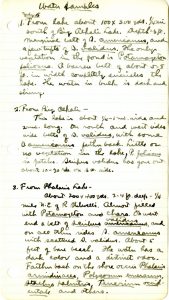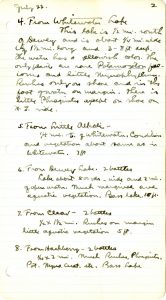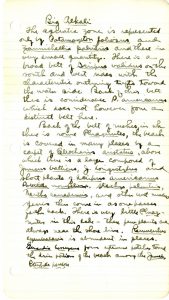Great Nebraska
Naturalists and ScientistsRaymond J. Pool, Notes, 1912, Part 3
59
along such rivers and smaller streams where the soil is always wet. The association
then as a rule presents a bilateral form in contrast to the diffuse or meadow form
of the above two associations. I have included under this association the “Spring
Marsh Type” and the “Spring Brook Types” of Pound and Clements, because it is very impossible to differentiate with constancy between these two
types except in mere position. Physiographically and ecologically they are identical.
“The most of the streams of the Sand Hills rise in a meadow like area which is well provided with springs. In many such places
the meadow conditions and vegetation is as I have described it above. Sometimes there
are differences introduced by the presence of Impatiens biflora in abundance and the Willow Hubs. Epilobium lineare and E. adenocaulon. Here also occur Rumex britannica, R. hydropiperoides, Helenium autumnale, and Cicuta occidentalis. But these are likewise very common members of the meadow associations described
above. In the wetter situations such species as Mimulus jamesii, Berula
Zizania aquatica, Eupatorium purpureum, E. perfoliatum, Homalocenchrus are also common.
60
erecta and Eriophrum gracile are developed in great profusion. So also upon springy ground is found Onoclea sensibilis and Dryopteris thelypteris, often associated together, and Campanula aparinoides with its characteristic dense aggregation. In addition to the above wet meadow species
Lobelia spicata, Ranunculus sceleratus, R. cymbalaria, Scutellaria lateriflora, D. galericulata, and [Bidens laevis?] and B. frondosa. Grasses and sedges that are frequent in this association are Panicularia americana, Catabrosa aquatica, Phalaris arundinacea, Phragmites phragmites, Eleocharis palustris, E. acuminata, Scirpus validus and S. americanus, Eriophorum gracile, besides a number of hydrophilous species of Carex.
The “Spring Brook” type of Pound and Clements is simply the cutting down of the above “Spring meadow Marsh” type into narrow and more or less discontiunous strips that follow down along the
streams. Where tributaries enter a main stream the type may broaden considerably and
assume the “spring marsh” type again and so on. Other species that are more or
61
less common in both places but a little more abundant in the latter are: Mentha canadensis, Lycopus lucidus and L. americanus, and Lobelia siphilitica, with Sagittaria latifolia, Galium trifidum, Gerardia besseyana, and the Eleochari there show a very decided alliance with the meadow associations as outlined above.
Perhaps the greatest difference between there two associations is in the relatively
greater constancy of the latter type as composed with the other wet meadow associations.
Because of the presence of immersable springs of constant flow it appears that the
streams that take their origin in such places are everlasting and run with very steady
volume so that later stages in the successor take place very much slower than in the
case of the meadow association where is some cases the succession is rather rapid
especially during a series of dry seasons.
62
The Marsh Formation
The Marsh Formation stands midway between the Water Plant Formation on the other.
The most distribution is Scirpus Validus, the common bul — rush. In the wet valleys about ponds and lakes and along stream
courses throughout the region this specias is to be seen in characteristic dark green
areas. With the above species there are associated Typha tabfolia, Phragmites phragmites, Alisma plantago-aquatica, Sagittaria latifolia, and an occasionally patch of Sparganium eurycarpum. These species constitute the facies of the Reed — Grass Rush Association of the
Marsh Formation.
The most characteristic expression of the Reed — grass Rush Association occurs about
the numerous lakes and ponds of the northern portion of the region. The most frequent
and abundant facies Scirpus validus in Phragmites phragmites. These two facies very often alternate in the association or frequently one may find
areas that are completely dominated by one or the other facies is almost if not entirely
absent. Sometimes the one is exercising leadership in the succession i.e. is found
on the water front and
Phalaris arundinacea is often developed in this association to a very noticeable degree and in an abundance
as to control certain areas. These areas, often covering several acres, are as conspicuous
as ripe wheat fields which they which they resemble in late July when the spilalets
are ripe.
Frequently one finds this grass mingled with Scirpus in various “concentrations.”
Sagittaria arifolia sometimes forms a complete belt about ponds and lakes between the R — Rush assoication
and the Rush Meadows.
63
sometimes the other occupies this position. So also in the last stages of the succession
Scirpus may in some instances be the last to leave and in others Phragmites may persist to the last as a few straggling individuals scattered about the wet meadow.
These two facies behave differently however in invading a pond or lake Scirpus usually progresses by sending out a very thin fringe of a few hardy individuals,
or by a few widely isolated clumps of scattered individuals. From these centers of
distribution rhizomes are sent out that gradually increase the area covered by the
species. On the other hand Phragmites invades by a solid front seldom sending aout the scattered individuals or clumps.
The habit is responsible for the great bank or wall effect produced by the latter
species as one looks at it from the water side sometimes such a bank as this lies
between the open water and the first plants of Scirpus which are as a rule aggregated into a dense belt. In the lakes are ponds that are
strongly alkaline Phragmites is entirely absent it seeming to be quite sensitive to an alkaline
64
substratum. In the fresher lakes the two are almost always found alternating throughout
the association which in Cherry Co. covers hundreds of acres about lakes and in wet valleys.
In and about some of the lakes Zizania aquatica assumes the role of facies where it is developed in great beds which in position
are usually behind both Scirpus and Phragmites. Occasionally Zizania occurs in extensive pure stands just in front of the Rush Meadow Association, but
more frequently it occurs in mixture with Scirpus. The bright green of Zizania quite effectively differentiates it from both the Scirpus and Phragmites. Where the three are associated the color grade is Scirpus and very deark green, Phragmites lighter, and Zizania light green.
Typha latifolia is a frequent member of the association as it occurs in the Sand Hills, but it seldom if ever assumes the importance of a facies, but may persist until
late in the succession where present.
Between the clumps of Scirpusand the bays between larger areas of Scirpus and Phragmites, and in scattered stands of Scirpus the other species of the association due to been seen in considerable abundance.
65
Sagittaria latifolia is frequently seen in extensive stands of closely grouped individuals. The same is
true for
Alisma plantago—aquatica, Sparganium eurycarpum is also frequently developed in patches within the association. When Phragmites is developed in dense pures strands in shallow water it is completely sociably exclusive.
In the drier portions or higher portions of the marsh there is unusually a carpet
of moss or Eleocharis acicularis on the ground among the stems of the facies.
The Smartweed Association
As the water recedes beneath the Reed grass Rush association there are a number of
species that soon come in. One of the commonest facies of this stage in the sucession
is the smartweed — Polygonum hartwrightii, P. exsertum, P. amphibium are often seen here in such confined variation that it is indeed impossible to clearly
differentiate between the three species. P. emersum is properly a member of the next association, but as subsidence approaches it very
readily assumes the amphibous habit and then later becomes a true land form on P.
hartwrightii which
Rumex persicarioides is occasionally seen in small clusters or simply in the more open areas especially
where this association gives way directly to the Hay Meadow Association.
Alisma plantago — aquatica frequently completely dominates the inner area of a pond or lake that has recently
“dried up?”
66
often appears on the same rhizome and may remain sterile for the whole season, or
only a few of the plants producing flowers and fruit. The individuals in this association,
which may be in the form of a belt or zone about a lake or meadow, stand very close
together so that scarecely a single additional species is to be found here. In the
more open areas P. persicaria, and P. hydropiperoides sometimes seen. The latter sometimes develops the same dense patches which alternate
with the other facies. In some muddy swamps few or none of the above species are to
be found but the association is represented by dense P. pensylvanicum, which is a common ruderal throughout the hills.
The Carex Riparia Asscociation
This association of which the single facies is Carex Riparia should really precede the Smartweed association since in many places it occupies
the ground between the latter association and the Reed grass Rush assoication. Sometimes
however this order is just revered so that it is perhaps better to regard this assoication
as regularly alternating with the smartweed association. The latter is moslty characteristic
of muddy
67
The soil of this association is always covered by water until late in the spring.
68
situations however while the former is always found over a sandy substrata and one
with usually a lower water content. The plants of
C. riparia stand alone together and form a wide expanse of deep green grassy vegetation of about
1 m. in height broken only by an occasional tuft of
Typha latifola or
Scirpus lacustris relicts of a former association. The only semblance of a second layer is seen in
scattered
short individuals of the
Sagitaria latifolia that are also relicts from the Reed grass Rush Association. Where the association
becomes open, as on the outer border, it rapidly pauses into the wet meadow series
by the coming in of Eleocharis or Dryopteris. Very frequently this association is extremely rough surfaced became of the tramping
of stock and in such places it is characteristic to find the facies restricted to
the inumerable low hammocks between which one occasionally seeds another relict in
the form of Rumex brittanica, and there may be plant a thin carpet of mosses, and a few spindling individuals
of associations of normally drier situations.
68
The Water Hemlock Association
This association, of which the facies is Cicuta occidentalis, occurs on a variety of situations especially in regards to water content and it
might in some cases be classified under the wet meadow series as readily as with the
marsh series.
About the ponds and lakes and it ravines that are more or less swampy this species
is often developed to a decidedly controlling degree when in blossom the dense stands
giving a most striking appearance to low meadows or marshes. Its relation to the Marsh
Series is often shown by the presence of much Scirpus atrovirens and S. americanus, and Asclepias incarnata, while its relation to the Hay Meadow association is revealed by the fact that it
is often found in extensive stands of scattered individuals within that association.
It in most cases prefers a sandy rather than a loamy sustratum. Common secondary species
found under the more marshy conditions are: Spartina cynosuroides, Phalaris arundinacea, Berula erecta, Stachys palustris and Teucrium occidentale. In such situations there are few
69
or no low growing species, but where the association becomes one of a wet meadow native
there are many such secondary species to be found.
In general the association is a hydrophilous one with a very decided tendency to become
a merophilous one and to be linked more with the meadow associations than with the
marsh series.
Also in cut off lakes along the course of the Dismal River.
70
The Water Plant Formation
The plants that comprise this formation may in most cases be classified into two vegetation
forms: submerged aquatics and floating or free swimming forms. There are three well
defined and widely distributed associations represented in this formation as it occurs
in the Sand Hills.
This is the most frequent of the three associations and the one in which the individuals
are most densely aggregated. Represented by one or more of its facies this association
is developed to greater degree in the ponds and lakes of the northern portion of the
region and to a lesser degree along rivers and spring branches wherever they are found.
The facies are species of Potamogeton of which P. richardsonii, P. foliosus, P. zosterifolius, P. pectinatus, P. spirillus, and Myriophyllum spicatum, Ceratophyllum demersum, and Zannichellia palustris. In many of the ponds and lakes that are not to strongly alkaline combinations of
these species are so abundant and luxuriant as to make boating very difficult, and
in some lake well nigh impossible during late summer
Potamageton natans and P. lonchites are common species with floating leaves.
Discuss substratum here too.
Polygonum emersum
71
when the various facies have reached their full development. Since the ponds and lakes
are all shallow(seldom exceeding 10ft) there species are developed to a very great
abundance. In summer as one looks down into there bodies of water the appearance of
the vegetation is that of an aquatic forest of slight stature especially if the plants
are Myriophyllum or Ceratophyllum or one of the upright stemmed Potamogetons such P. zosterifolius or pectinatus. It is a rather interesting fact that the various species are seldom mixed to any
degree but rather alternate in practically pure communities. Thus in rowing say 500
yds. one may pass over pure colonies of Myriophyllum, Ceratophyllum, and three pure beds of P. Richardsonii, P. Natans, etc. In the shallower water where there are openings between the communities of
larger plants Lemna trisulca is often developed in enormous beds so that this light green color contrasts very
markedly with the generally duller surrroundings. The stems and leavese of all there
facies are frequently thickly set with bullate colonies of such algae as Rivularia, and the float —
72
ing stems are often swathed in strands of filamentous algae such as Oedogonium, spirogyre, etc. The latter is liable to be true where the pond is small or for other reasons
the water becomes more or less stagnant. In the more alkaline lakes P. foliosus is frequently the only facies left and this is not to be found is the dense estensive
communities that characterize its habit in the fresher streams and lakes.
The Batrachium Association might well be merged with the Pondweed association since it occupies
practically the same habitat. The facies is Batrachium trichophyllum and the association occurs in cut off ponds along the Dismal and in fresh water ponds and lakes throughout the region. It is usually flowered
and reached it height of development before the pondweed association becomes especially
conspicuous. Sometimes the species persist as a secondary species of the Pondweed
Association. This association with its banks of white flowers in an especially striking
characteristic of the of the cognatic flora of the hills during the month of June.
It is also a frequent member of the Pond Lily Association as a secondary species.
73″
In small ponds and on the margins of spring branches especially there are a number
of associated species that are common during early summer. The commonest of there
are Veronica americana and the less common V. amagallis — aquatica: Mimulus parisherii, and Cardamine hirsuta. All of there plants show gradations from the truly land habit through the amphibous
to the truly submerged forms with all of the vegetative parts beneath the water and
only the flowering portions abouve as in Batrachium. Dulichium arundinaceum a rare amphibious sedge is seen in a similar relation along some of the spring branches
of the Niobrara. This association favors a muckly or loamy substratum while the Pondweed association
favors a sandy substrata. Because of this relation the Batrachium association is probably to be regarded as a later association.
74″
The Pond Lily Association
The ponds and streams in the Sand Hills that reveal this association are usaully rather old and filled in and are characterized
by the single facies Nymphaea advena. Very commonly the association exists as a zone or belt outside the Marsh association
holding a position midway between the Pondweed association is seen in scattered some areas over the shallow lakes or now and then mixed in with the Marsh Association
especially where Scirpus is the facies and the association is open. The best developed condition of the association
is seen however wher a pond or lake has been almost completely eradicated and little
open water with pondweed vegetation is left. About such waters as this the lily association
is seen developed as a belt several meters in width which the plants standing very
close together. This belt then gives way to a belt of Scirpus, Typha, or Phragmites as the case mabye of the Marsh
75″
association. In many old ponds and lakes the association is lacking entirely and is
such places the Marsh and Pondweed associations join in shallow water. This latter
is practically always the core is practically always the core in the larger lakes
before the lily association appears.
Secondary species such as Potamogeton natans and P. lonchites are occasionally present, as is also Polygonum amphibum, Sagittaris latifolia and other Potamogetons where the association is interupted by dense patches of Phragmites or Typha or looser areas of Scirpus.
107
“
Plants that are most frequent and abundant in Blow-outs.
- 1. Redfieldia flexuosa
- 2. Psoralea lanceolata
- 3. Phaca longifolia
- 4. Lathyrus omatus
- 5. Muhlenbergia pungens
- 6. Erogrostis trichodes
- 7. Artemsia canadensis
- 8. Penstemon hayderii
- 9. Anogra cinerea
- 10. Cristatella jamesii
- 11. Polarusia trachysperma
- 12.
- 13.
- 14.
- 15.
- 16.
“
Plants that are occaisionally seen in Blow-outs:
- 1. Yucca danca
- 2. Chrysopris viceosa
- 3. Sideranthus spinulosus
- 4. Prunus besseyi
- 5. Prunus melanocarpa
- 6. Rhus radicans
- 7. Eriogonum annuum
- 8. Andropogon hallii
- 9. Andropogon scoparius
- 10. Calamovilfa longifolia
- 11. Hymenopappus filifolius
- 12. Tradescantia virginiana
- 13. Cyperus schweinitzii
- 14. Amorpha canescens
- 15. Asclepias arenaria
- 16. Asclepias permila
- 17.
- 18.
- 19.
- 20.
- 21.
- 22.
- 23.
- 24.
- 25.
- 26.
- 27.
- 28.
- 29.
- 30.
“
July 29 — Atkinson to Erina
From Atkinson south for about ten mi. the soil is hard and the country level. This is a very well
kept up farming country with many fine groves of cottonwoods. About 11 mi. south this
kind of land cuts a big “bay” into the Sand Hills which extend northward on both the east and west. The Sand Hills from this point to Inez and Amelia are characterized by very broad valleys bound by few low ranges of hills which show
little bunch grass or Yucca. Amorpha Canescens abounds everywhere or the uplands. In these valleys there is much corn & wheat sowed
and by the greater area is in hay land. Many ranchers have sowed Timothy and Clover which their span is making a fine crop. The corn also looks good. The wild hay is
very fine. The flora of the wet meadows and hay meadows is the same as in Cherry Co.
From Amelia to Erina, in the valley of Cedar Creek. The hills are more typcial and the valleys are much narrower> Here also the Bunch
grass is well developed but there is little Yucca. Blowouts are infrequent.
“
Erina is in another fertile valley, that of Cedar Creek. Much farming and fine groves here. Stipa Comata is the most conspicuous grass on the uplands at this point. From Erina we drove to Burwell via Irvene.
This is much more to as Dwene and there are many large blowouts, and none or unimportant valley in which hay is
cut. Farming does not pay. The uplands are covered by the Stipa association in conspicuous
mixture with Amorpha Canescens which is here often controlling where the soil is inclined to be a little firm. Calamovilfa is very frequent here also. Huge blowouts.
From Divene to the valley of the North Loup & Calamus the hills are much finer and of clay which is good for farming. this neck of Sand Hills then extends from about 10 mi. S. Atkinson to Dwene, 10 mi. North of Burwell.
“
July 15
Phalaris Lake: 1 N.E. R. Stilwell‘s
About 400 yds x 200 yds. 2 — 4 ft. deep. This lake is almost filled with Potamageton foliosus and Chara. On west end a belt of Scirpus validus, but on most sides the first shore belt is S. americanus. This then merges into a belt of Hadenus jubatum mingled with lower plants of S. americanus. This then gives way to the typical wet meadow plants or in southwest portion to
Phalaris canariensis, a patch of several acres in area. The water is so alkaline that in lake it looks
coffee color
About this lake there are great stretches of Polygonum emersum, P. hartwrightii, Phalaris canariensis, Lycopus americanus, Stachya palustris, Teucrium occidentale
“
Water Samples
July 15
1. From lake about 100 x 300 yds. 1/4 mi. south of Big Alkali Lake. Depth 2 — 3 ft. Marginal belt of S. americanus, and a few tufts of S. validus. The only vegetation in the pond is Potamogeton foliosus. A barier belt of about 5 — 8 ft. in width completely encircles the lake. The water
in bulk is dark and shiny.
2. From Big Alkali—
This lake is about 1/4 — 1 mi. wide and 2 mi. long. On south and west sides wide belts
of S. Validus, with some S. americanus farth back. Little or no vegetation in the lake. P. foliosus in patches. Scirpus validus has gone out about 10 — 30 yds. on S.W. side.
From Phalaris Lake—
About 200×400 yds. 2 — 4 ft. deep — 1/4 mile N.E. of R. Stilweell‘s. Almost filled with Potamogeton and Chara. On west end a belt of Scirpus americanus validus, and on all other sides S. americanus with scattered S. validus. About 5 feet of bare beach. The water has a dark color and a distinct odor. Farther
back on the shore ocean Phalaris arundinacea, Polygonum emersum, Stachys palustris, Teucrium occidentale and others.
“
July 22
4. From Whitewater Lake
This lake is 1/2 mi. south of Dewey and is about 1/4 mi. wide by 1 1/2 mi. long and 3 — 8 ft. deep. the water has a yellowish
color. The only plants are rare Potamogeton folious and little Myriophyllum. Rushes only on shore and in the foot of water on margin. There is little Phragmites
except on shore of N.E. side.
5. From Little Alkali—
1/4 mi. E. of Whitewater. Condition and vegetation about same as in Whitewater. 7 ft.
6. From Dewey Lake. 2 bottles
Lake about 500 yds wide and 2 mi. of open water. Much margeal and aquatic vegetation.
Bass lake, 10 ft.
7. From Clear — 2 bottles
1/2 x 1 1/2 mi. Rushes on margin little aquatic vegetation. 5 ft.
8. From Hackberry — 2 bottles
1/4 x 2 mi. Much Rushes, Phragmites, Pot, Pot. Myro. Cerat. Etc. Bass Lake
“
Big Alkali
The aquatic zone is represented only by Potamogeton foliosus and Zamichellia palustris and these in very small quantity. There is a broad belt of Scirpus validus on the south and west sides with the characteristic outlying tufts toward the water
side. Back of this belt there is considerable P. americanus which does not however form a distinct belt here.
Back of the belt of rushes in wh. there is some Phragmites, the beach is covered in many places by a carpet of Eleocharis aristatus, above which there is a layer compesed of Juncus balticus, J. longistylus and short plants of Scirpus americanus, Potentilla monspeliensis, Stachys palustris, Mentha candensis, and other wet meadow species then come in as one passes farther back. There is very
little Phragmites in this lake — these few plants are always near the shore line.
Ranunculus cymbalaria is abundant in places. Gerardia besseyana forms extensive patches toward the drier portion of teh beach amoung the Junci Potentilla paradoxa
